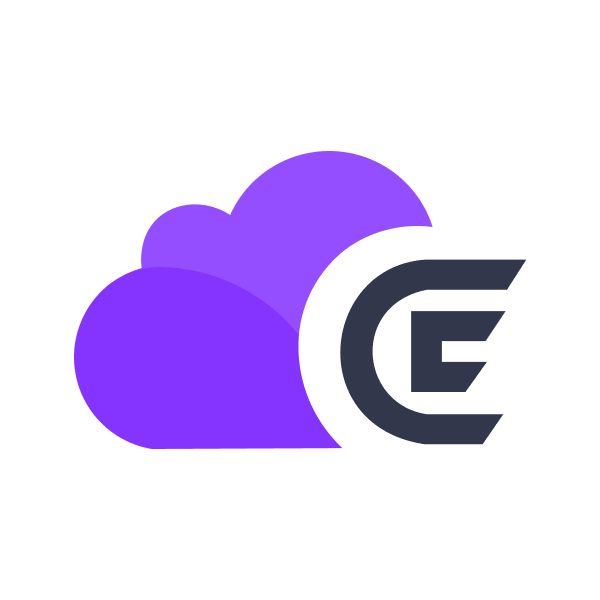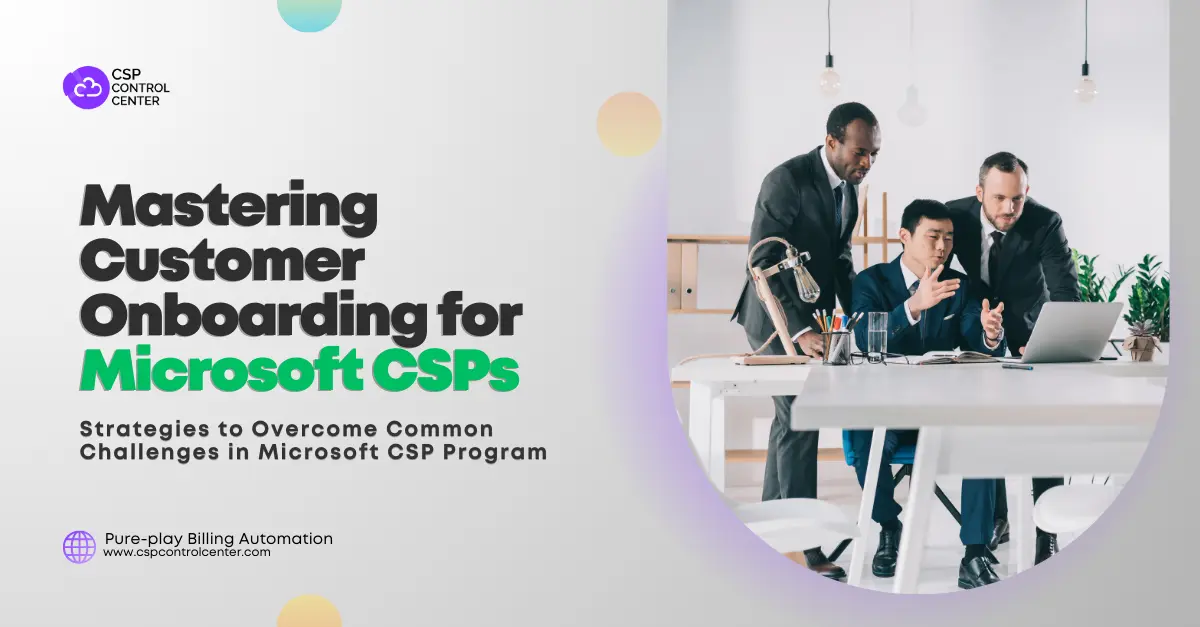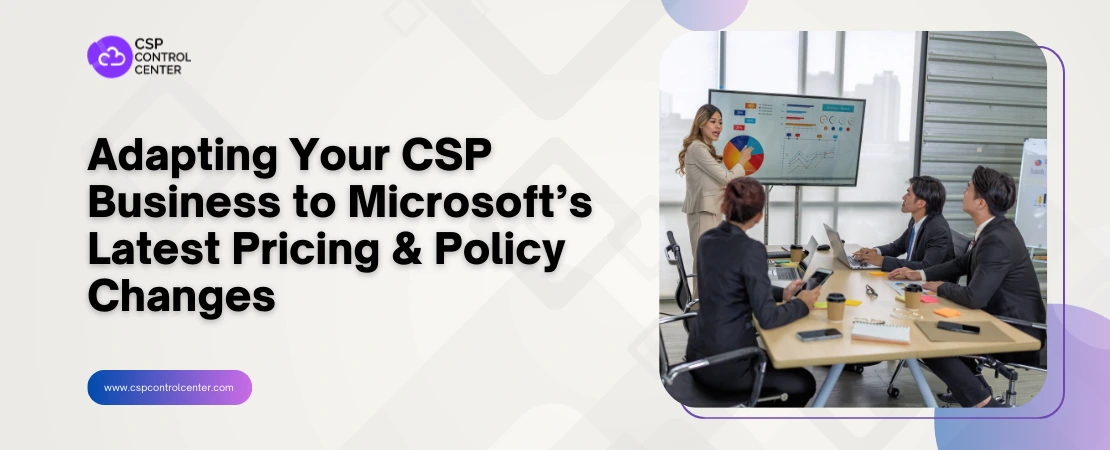In the rapidly evolving world of cloud computing, Microsoft CSPs play a vital role in delivering Microsoft’s suite of cloud services to customers. The success of your Microsoft CSP business depends not only on selling these services but also on effective new customer onboarding to ensure they get the maximum benefit from the services. Customer onboarding is one of the most critical phases in your relationship with your customers. This phase sets the tone for the entire customer experience, directly impacting satisfaction, retention, and long-term success. A smooth and efficient onboarding process not only fosters trust and confidence but also helps your customers quickly derive value from their cloud solutions. However, there are a lot of challenges you must overcome to have a successful customer onboarding experience.
Understanding the Customer Onboarding Process
Being a Microsoft CSP, you own the customer relationship and manage the entire customer lifecycle including billing, support, and customer onboarding. Customer onboarding involves welcoming new customers and guiding them through the process of adopting and integrating new cloud services. As a Microsoft CSP, this includes guiding customers through the complexities of the Microsoft cloud ecosystem, addressing their specific needs, and providing the necessary support for a smooth transition. The customer onboarding process involves several key stages including-
- Pre-onboarding– this stage involves gathering detailed information about the customer, including their business model, industry, and existing IT infrastructure. This needs assessment helps tailor the onboarding process.
- Account Setup and Migration– in this stage you must set up the necessary accounts, configure services, and manage the migration of existing data to the new cloud environment.
- Training and Support– after the technical support is done, you must provide training and education on how to use the product or service and address any issues that the customers might have.
- Ongoing Engagement and Optimization– Onboarding goes beyond the initial setup. As the customer’s business needs evolve, and new products and services are introduced it is essential to maintain continuous engagement. This ensures that customers can fully leverage the capabilities of their cloud solutions as their requirements change over time.
Potential benefits of a well-executed onboarding process
As a Microsoft CSP, there are several benefits of a well-executed onboarding process. If done correctly, it lays the foundation for a long-lasting business relationship. Here are some of the key benefits:
Enhanced Customer Satisfaction
A smooth and efficient onboarding process creates a positive first impression and ensures that customers feel valued and supported from the very beginning. It helps customers quickly understand and start using Microsoft solutions, resulting in faster time to value leading to increased customer satisfaction. A structured onboarding process can minimize customer frustration and create a more positive experience.
Opportunity for Upselling and Cross-Selling
A well-structured onboarding process will give you insights into customers’ specific needs and business goals. This will help identify opportunities for upselling and cross-selling additional Microsoft products or services. Also, satisfied customers are more receptive to additional offerings as they see the value in Microsoft products and your service. Also, demonstrating how these additional solutions can address their pain points further strengthens your position as a trusted advisor. This further increases the likelihood of customers purchasing complementary services and products. To learn how to increase your Microsoft CSP revenue by upselling and cross-selling click here.
Increased Customer Retention
A positive onboarding experience can help foster stronger relationships with your customers. When customers realize the value of the products and services early on and experience a smooth onboarding process, they are less likely to churn. According to Customer Onboarding Benchmark Report 2021 by Precursive, “Poor onboarding ranks as the third most key factor leading to customer churn, following wrong product fit, and lack of engagement“. Reduced churn rates lead to higher customer lifetime value (CLV). A higher CLV translates into increased revenue for your Microsoft CSP business. Read our blog to learn more about how using a Microsoft CSP billing solution can help increase customer lifetime value.
Competitive Advantage
A superior onboarding process can differentiate you from other Microsoft CSPs and help attract and retain more customers. A positive customer experience can enhance your reputation and credibility in the market, positioning you as a trusted and reliable partner. This will help you acquire new customers and retain existing ones, expanding your market share.
Reduced Support Costs
A thorough onboarding process significantly reduces the number of support tickets and ongoing assistance required. A well-structured onboarding process can ensure customers have the necessary knowledge to use Microsoft solutions effectively, reducing the need for support calls. This lowers the operational costs and improves profitability. Additionally, by addressing common issues during onboarding, you can prevent potential issues before they become major problems. This not only enhances customer satisfaction but also allows your support team to focus on more strategic tasks.
Customer Advocacy
Satisfied customers who have experienced seamless onboarding are more likely to recommend your services to others. They can become your advocates and promote your business through positive word-of-mouth and referrals. You can gain positive customer testimonials and grow your customer base organically. Customer endorsement not only helps attract new customers but also enhances your brand’s credibility and trustworthiness in the market.
Common Challenges in Customer Onboarding
While onboarding your customers you can face a range of obstacles that can complicate the onboarding journey. Addressing these challenges effectively is crucial for ensuring a smooth transition and building strong customer relationships. Here are some of the most usual challenges:
Complexity of Cloud Solutions
Microsoft’s suite of cloud solutions can be complex and have many features. Customers with limited technical knowledge might find it difficult to learn new tools and processes without proper guidance. Understanding and managing Microsoft licensing requirements can be challenging as well. Without clear instructions and support, this complexity can lead to delays in adoption and frustration among customers. According to userpilot, “74% of potential customers will switch to other solutions if the onboarding process is complicated.”
Customer Expectations
Customers may have unrealistic expectations regarding the capabilities of Microsoft solutions or the speed of implementation. Customers may underestimate the complexity of migrating to the cloud or integrating with existing systems. Customer needs and requirements can change during the onboarding process, or there may be tight deadlines for implementing cloud solutions. These can create pressure, lead to delays, and increase the risk of errors. Ensuring customer satisfaction throughout the onboarding process can be difficult.
Data Migration Issues
Migrating data from on-premises systems or other cloud platforms to Microsoft solutions can be challenging. Any data loss or corruption during migration has significant consequences for the customer’s operations. Downtime during migration can disrupt business activities, leading to frustration and potential financial losses. Additionally, during data transfer, there is a risk of sensitive data being exposed or compromised.
Customization and Integration Needs
Your customers may require customized solutions or integration with existing systems that can complicate the onboarding process. It will require additional work and can lead to delays in the onboarding process. You need to ensure that the solutions being implemented align perfectly with the customer’s existing systems and processes. Ensuring compatibility between cloud solutions and existing systems can be a challenge, especially if the customers have outdated infrastructure and legacy applications.
Resource Constraints
You might have limited staff to dedicate to onboarding or may lack the necessary expertise or skills to effectively manage the onboarding process. These limitations can result in delays or inefficiencies in the onboarding process. Apart from a lack of expertise and limited staff, budget constraints could also impact on the quality of onboarding. This can lead to a sub-optimal onboarding experience, where customers may not receive the full support, they need.
Change Management
Customers might be reluctant to adopt modern technologies or alter established workflows. This resistance from customers can slow down the onboarding process and delay technology adoption. Customers may hesitate to fully embrace innovative technologies or change their existing processes due to fear of disruption or uncertainty.
Training and User Adoption
Without proper training, your customers might struggle to fully utilize the features and capabilities of Microsoft solutions. Customers may only use a fraction of the available features and miss potential benefits. Insufficient training can also cause frustration among users, leading to resistance or reluctance to adopt the latest technology. Training can require significant investment of time, resources, and effort which might be difficult if you have resource constraints. Additionally, customers often have varying levels of technical expertise, making it difficult to create a one-size-fits-all training program.
Ineffective Communication
Communication gaps such as unclear instructions, misaligned expectations, or lack of regular updates, can lead to misunderstandings and delays. This can result in frustration for both your customer and you and may result in poor onboarding experience. Inconsistent communication can lead to confusion, missed deadlines, incorrect implementations, and unmet customer expectations. This can make it difficult to achieve a successful onboarding outcome.
Strategies to Overcome Customer Onboarding Challenges for Microsoft CSP
Failure to design and implement a customer-centric onboarding process that provides a positive experience leads to customer frustration and dissatisfaction, reduced product adoption, higher support costs, missed revenue opportunities, etc. Therefore, overcoming the common customer onboarding challenges is vital for the success of your Microsoft CSP business. Here are some strategies to help you achieve that:
Tailor Onboarding Plans
Each customer has different business goals, technical expertise, and operational needs. For successful onboarding, you must tailor your onboarding plans to match the specific requirements of each customer. You can start by conducting a thorough assessment of the customer’s existing infrastructure, specific requirements, and goals. Using this information, you can develop customized onboarding plans that align with the customer’s goals and technical capabilities.
Simplify Complex Cloud Solutions
Microsoft’s cloud solutions can be overwhelming for new customers. Break down these complex solutions into simple and understandable terms. Use clear, non-technical language to explain key concepts. Use visual aids, such as diagrams and step-by-step guides, to make the onboarding process more approachable. You can also consider implementing a phased approach where you start with core services before introducing advanced features.
Enhance Communication
Effective communication is vital for a smooth onboarding process. To enhance communication, you should maintain open and transparent communication channels throughout the onboarding process. Keep in regular contact with your customers and set expectations early on. Keeping customers informed about the progress helps prevent misunderstandings, aligns expectations, and builds trust between you and your customers.
Leverage Technology
Utilize tools and technologies to streamline the onboarding process. Utilize automation tools to streamline administrative tasks and improve efficiency. For e.g., a Microsoft CSP billing automation tool can simplify billing, provide transparency, and reduce errors. You can also provide customers with self-service portals for accessing information and managing their accounts. consider using project management tools to track onboarding progress and ensure that all tasks are completed on time.
Provide Comprehensive Training
A comprehensive training program ensures that customers can fully utilize the Microsoft solutions you provide. Offer tailored training programs that address the customer’s specific needs and skill levels. Create various training materials such as video tutorials, user guides, and interactive modules to cater to different learning styles. Regularly assess the effectiveness of the training and offer additional support where needed. Offer ongoing support to your customers so that they can maximize the value of Microsoft solutions.
Allocate Resources Efficiently
Prioritize resource allocation by focusing on the most critical aspects of onboarding and investing in areas that will have the greatest impact. You can leverage data analytics to predict resource needs and optimize allocation. You can also consider cross training your team to handle multiple aspects of onboarding.
Address Security and Compliance Concerns
Any security and compliance concerns that your customers might have should be addressed early in the onboarding process. Start by clearly communicating how Microsoft solutions adhere to industry standards and regulations, such as GDPR, HIPAA, or ISO/IEC 27001. Click here to learn more about customer security and compliance. Explain to your customers how data will be managed, stored, and protected within the Microsoft cloud environment. Develop and follow strict protocols for secure data migration and handling. Assure your customers that security and compliance are continuously monitored.
Streamline your Microsoft CSP Operations with C3
Are you ready to transform the way you manage your Microsoft CSP business? CSP Control Centre or C3 can help streamline every aspect of your operations, from customer onboarding to billing and support. With features like automated billing, advanced reporting, subscription management, and customer self-service, you can focus on what truly matters—growing your business. C3 enables you to deliver faster, more reliable services to your customers, helping you build stronger relationships and increase customer loyalty.
Contact us to learn more about how C3 can help you build stronger customer relationships and drive business growth.

 CSP Control Center
CSP Control Center
 CloudEvents
CloudEvents


